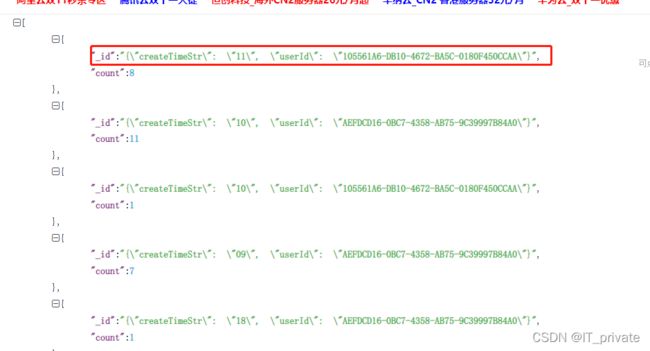Mongodb分组查询
库里的数据
简单分组查询
//封装查询条件
List operations = new ArrayList<>();
//根据用户id in查询
operations.add(Aggregation.match(Criteria.where("from").in(ids)));
//然后分组
operations.add(Aggregation.group("from").count().as("count"));
Aggregation aggregation = Aggregation.newAggregation(operations);
AggregationResults aggregateData = imMongoTemplate.aggregate(aggregation, "chat_history", CustomerStatisticsDTO.class);
List data = aggregateData.getMappedResults();
System.out.println(JSON.toJSONString(data)); //根据pageName和userId
Query query = new Query(Criteria.where("pageName").is(TaskTypeEnum.VIEW_SUCCESS_SERVICE.getPageName()).and("userId").is(v));
//创建时间倒叙 取第一条
query.with(Sort.by(Sort.Direction.DESC, "createTime")).limit(1);
CustomerStatisticsDTO statisticsDto = mongoTemplate.findOne(query, CustomerStatisticsDTO.class, "buried_point");复杂分组查询
库里的数据
1.根据pageName字段查询和时间区间和格式化时间类型的查询
//封装查询条件
List operations = new ArrayList<>();
//检索pageName字段
operations.add(Aggregation.match(Criteria.where("pageName").is(TaskTypeEnum.VIEW_SUCCESS_SERVICE.getPageName()).
//大于等于
and("createTime").gte(new Date(1638316845000L))));
//小于等于
operations.add(Aggregation.match(Criteria.where("createTime").lte(new Date())));
//date类型 转成字符串 $dateToString 函数
operations.add(Aggregation.project().andExpression("{$dateToString:{ format:'%Y-%m-%d',date: '$createTime'}}").as("createTime"));
Aggregation aggregation = Aggregation.newAggregation(operations);
AggregationResults aggregateData = mongoTemplate.aggregate(aggregation, "buried_point", CustomerStatisticsDTO.class);
System.out.println(JSON.toJSONString(aggregateData.getMappedResults())); format:需要返回的日期式,日期格式通常为以: %Y Year (4 digits, zero padded) 0000-9999 %m Month (2 digits, zero padded) 01-12 %d Day of Month (2 digits, zero padded) 01-31 %H Hour (2 digits, zero padded, 24-hour clock) 00-23 %M Minute (2 digits, zero padded) 00-59 %S Second (2 digits, zero padded) 00-60 %L Millisecond (3 digits, zero padded) 000-999 %j Day of year (3 digits, zero padded) 001-366 %w Day of week (1-Sunday, 7-Saturday) 1-7 %U Week of year (2 digits, zero padded) 00-53 %% Percent Character as a Literal $dateToString 可以替代为$dayOfYear: 返回该日期是这一年的第几天。(全年366天)
$dayOfMonth: 返回该日期是这一个月的第几天。(1到31)
$dayOfWeek: 返回的是这个周的星期几。(1:星期日,7:星期六)
$year: 返回该日期的年份部分 $month: 返回该日期的月份部分(between 1and12.)
$week: 返回该日期是所在年的第几个星期(between 0and53)
$hour: 返回该日期的小时部分 $minute: 返回该日期的分钟部分
$second: 返回该日期的秒部分(以0到59之间的数字形式返回日期的第二部分,但可以是60来计算闰秒。)
$millisecond:返回该日期的毫秒部分(between 0and999.)
2.先根据pageName字段,然后取时间区间,然后把时间格式化为小时,然后分组,倒叙,求一段时间内的那个小时内用户访问量最大
//封装查询条件
List operations = new ArrayList<>();
//检索pageName字段
operations.add(Aggregation.match(Criteria.where("pageName").is(TaskTypeEnum.VIEW_SUCCESS_SERVICE.getPageName()).
//大于等于
and("createTime").gte(new Date(1638316845000L))));
//小于等于
operations.add(Aggregation.match(Criteria.where("createTime").lte(new Date())));
//只看小时
operations.add(Aggregation.project().andExpression("{$hour:{date: '$createTime'}}").as("createTime"));
//分组 之后count求数量
operations.add(Aggregation.group("createTime").count().as("count"));
//根据count数量倒叙
operations.add(Aggregation.sort(Sort.by(Sort.Direction.DESC, "count")));
//取第一条
operations.add(Aggregation.limit(1));
Aggregation aggregation = Aggregation.newAggregation(operations);
AggregationResults aggregateData = mongoTemplate.aggregate(aggregation, "buried_point", CustomerStatisticsDTO.class);
System.out.println(JSON.toJSONString(aggregateData.getMappedResults())); 3.多字段分组之后结构会发生改变
//封装查询条件
List operations = new ArrayList<>();
//检索pageName字段
operations.add(Aggregation.match(Criteria.where("pageName").is(TaskTypeEnum.VIEW_SUCCESS_SERVICE.getPageName()).
//大于等于
and("createTime").gte(new Date(1638316845000L))));
//小于等于
operations.add(Aggregation.match(Criteria.where("createTime").lte(new Date())));
//只看小时
operations.add(Aggregation.project().andInclude("userId").andExpression("{$dateToString:{ format:'%H',date: '$createTime'}}").as("createTimeStr"));
//分组 之后count求数量
operations.add(Aggregation.group("createTimeStr", "userId").count().as("count"));
//重新定义字段
//operations.add(Aggregation.project("createTimeStr", "userId", "count"));
Aggregation aggregation = Aggregation.newAggregation(operations);
AggregationResults aggregateData = mongoTemplate.aggregate(aggregation, "buried_point", CustomerStatisticsDTO.class);
System.out.println(JSON.toJSONString(aggregateData.getMappedResults())); operations.add(Aggregation.project("createTimeStr", "userId", "count"));如图:多出来了两列



